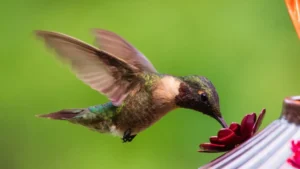In the warmer months, the ruby-throated hummingbird makes a stop in our state. It’s the only hummingbird species that visits here, and while it’s just passing through, some stay to breed during summer. These tiny birds travel thousands of miles every year, spending winters in Central or South America and returning north to nest.
If you want to enjoy their fast-flying beauty up close, there are a few simple things you can do to make your yard a hummingbird hotspot. Here are five tips that will help you attract them—and keep them coming back.
1. Set Up a Hummingbird Feeder
One of the easiest ways to invite hummingbirds to your yard is to hang a nectar feeder. These feeders are designed to hold a sugar-water solution that mimics the natural nectar they drink from flowers.
You can buy pre-made nectar, or make your own at home. It’s easy: mix 1 part white sugar with 4 parts water, stir until the sugar dissolves, and pour it into your feeder.
Important: Only use plain white granulated sugar. Do not use brown sugar, honey, molasses, or artificial sweeteners—they can harm the birds.
2. Skip the Red Dye
Many feeders are red because hummingbirds are attracted to bright colors—especially red. While this helps catch their attention, you don’t need to add red food coloring to the nectar. Some experts even say dye could be harmful over time.
Stick to clear sugar water. If your feeder already has red parts, that’s enough color to draw them in.
3. Keep Feeders Clean
Dirty feeders can quickly become dangerous. Sugar water left out in the heat can grow mold or bacteria, which is harmful to hummingbirds.
To keep things safe:
- Clean your feeder every 3 to 7 days, depending on the temperature.
- Use hot water and scrub well—avoid strong chemicals.
- Rinse thoroughly before refilling.
Also, keep an eye out for ants or bees getting into your feeder. Some feeders come with built-in ant guards, which can help.
4. Place Your Feeder in the Right Spot
Hang your feeder in a shaded area to help the nectar stay fresh longer. Avoid direct sunlight when possible.
Also, be careful placing it near large windows. Birds might get confused by reflections and fly into the glass. If you want to enjoy the view from indoors, try putting the feeder 5–10 feet away from windows and add stickers or patterns to make the glass visible to birds.
Bonus Tip: Plant colorful flowers nearby to give hummingbirds more places to feed—and to attract insects they also eat.
5. Create a Pollinator Garden
Hummingbirds don’t live on nectar alone—they also eat small insects for protein. A garden filled with flowers helps in two ways:
- Flowers offer natural nectar sources.
- Flowers attract insects, which become food for the hummingbirds.
Choose flowers that bloom throughout spring, summer, and fall to keep your garden active all season. Red bee balm, trumpet vine, salvia, and columbine are great choices.
A variety of native flowers also supports butterflies and bees, making your garden even more vibrant.
FAQs: All About Hummingbirds in Your Yard
Q1: How long should I keep my feeder out?
Keep feeders up through October. Some hummingbirds stay late into fall and need extra food as insects become harder to find.
Q2: Do I need to boil the water for nectar?
Boiling isn’t required but helps the sugar dissolve faster and may keep the nectar fresh a bit longer.
Q3: How can I keep ants away from the feeder?
Use feeders with ant moats or hang them from fishing line—ants have a hard time climbing slippery string.
Q4: Will other birds or animals use the feeder?
Mostly, no—hummingbird feeders are designed for their tiny beaks. But bees, wasps, or even squirrels might try. Clean up spills to avoid pests.
By following these simple steps, you’ll create a hummingbird-friendly yard that not only attracts these tiny wonders but also helps support them during their long migration. Plus, you get a front-row seat to one of nature’s most fascinating flyers.

